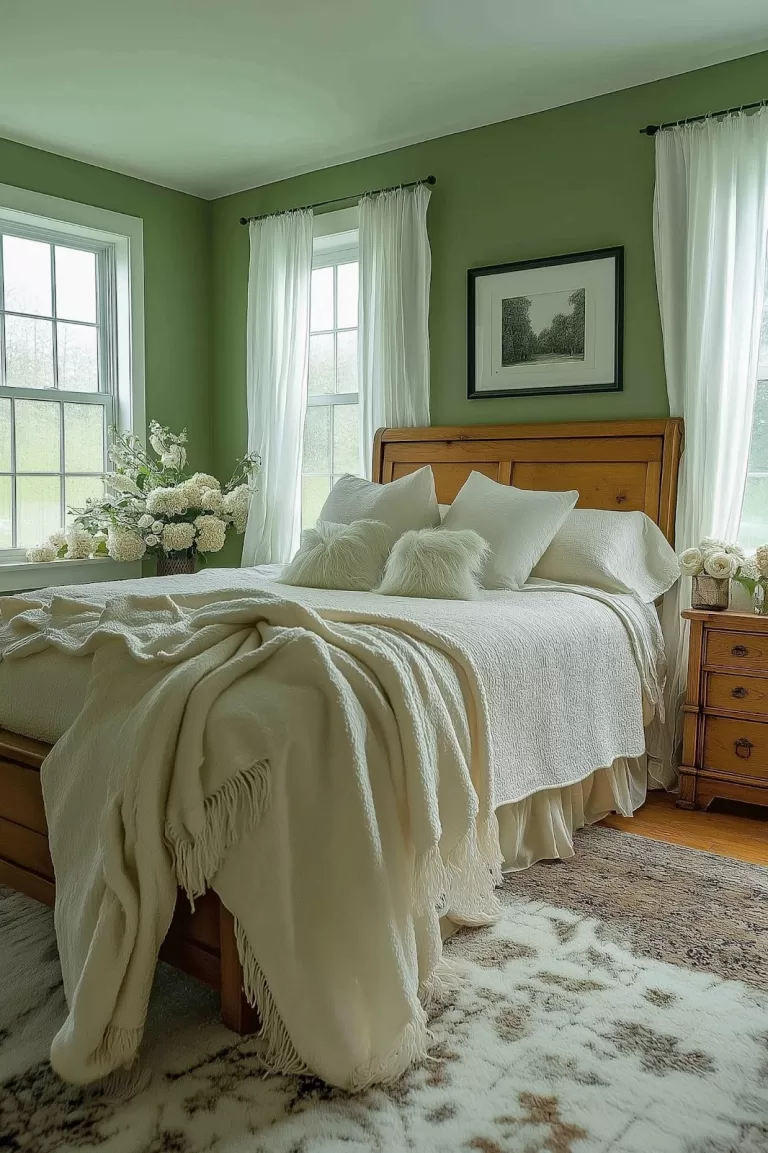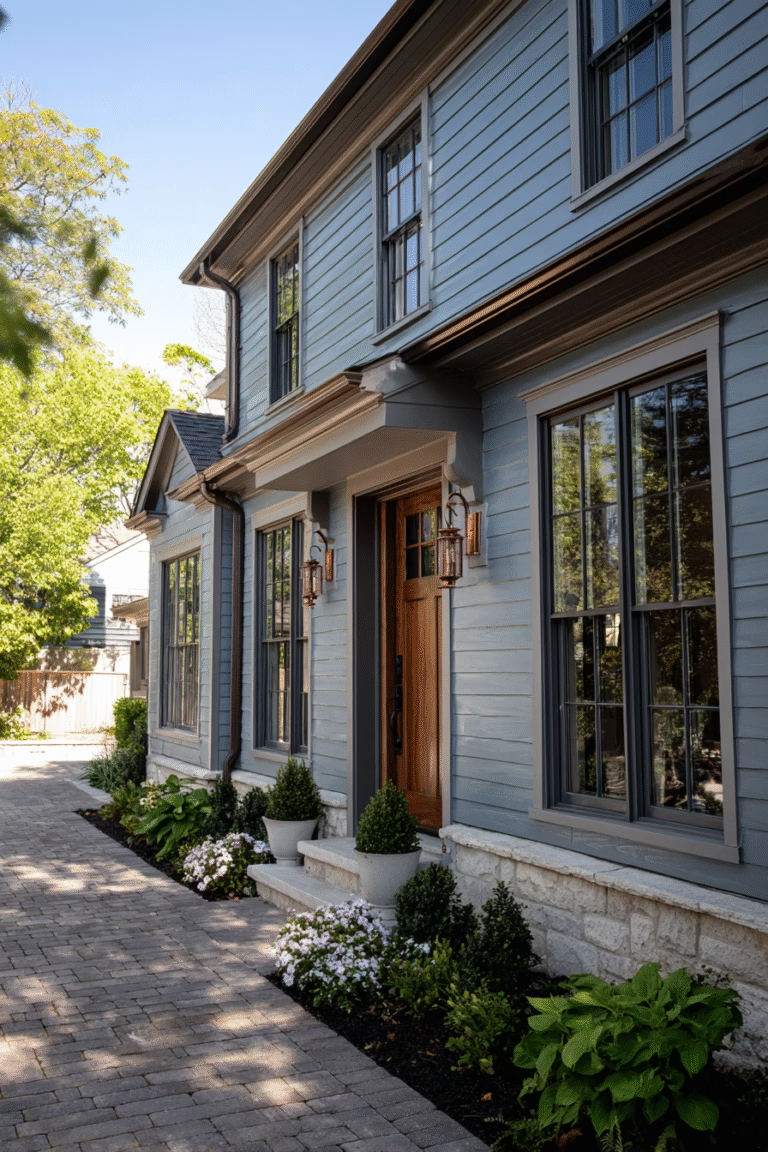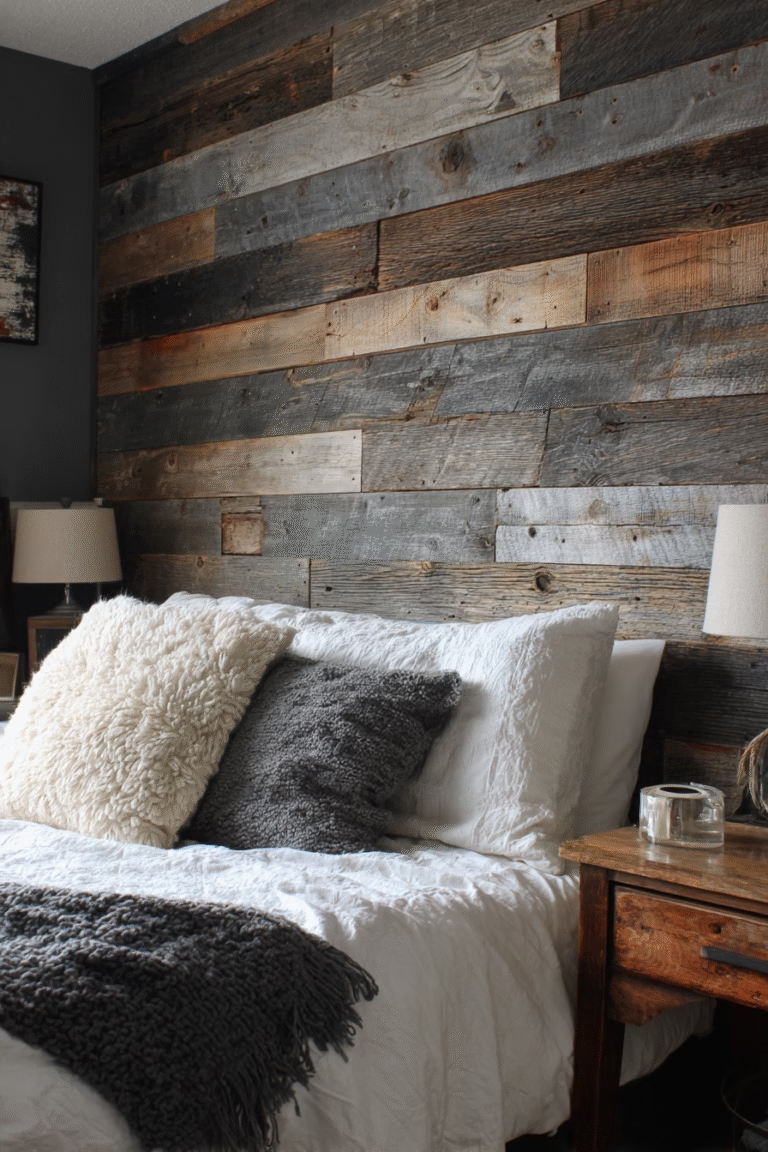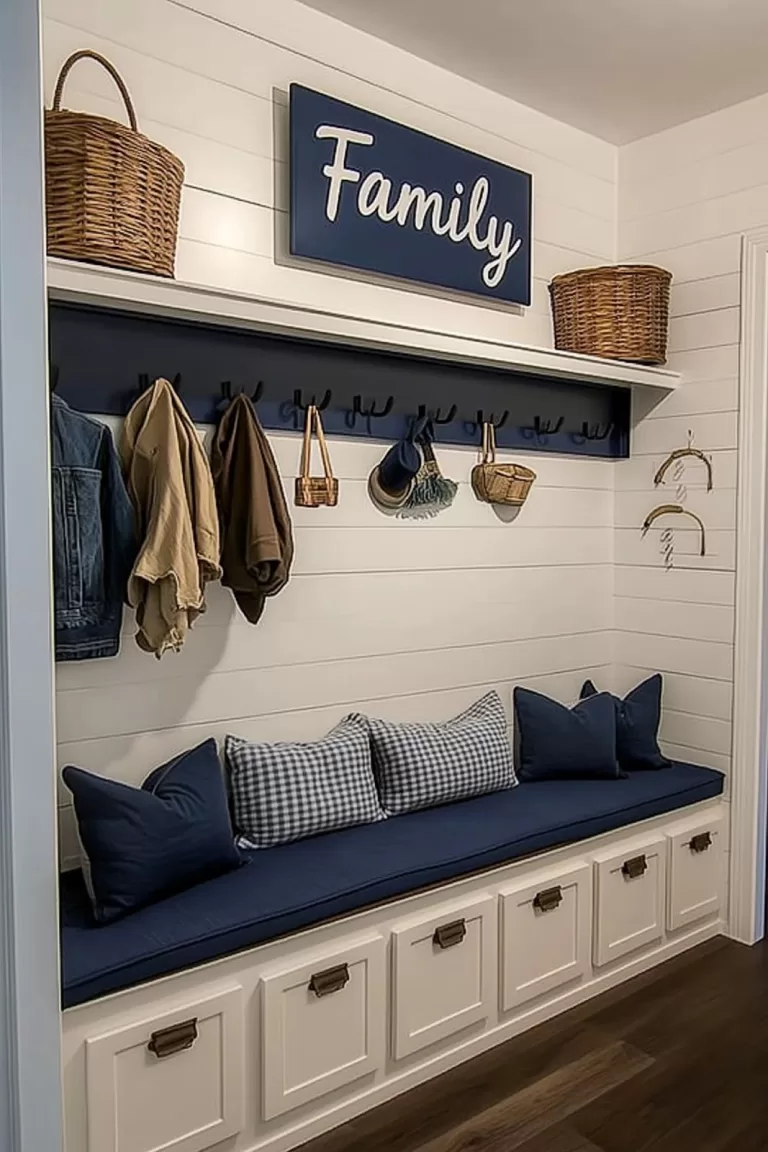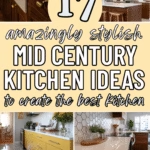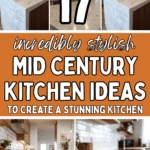17 Mid Century Kitchen Ideas Designs for Modern Retro Style
This site contains affiliate links. As an Amazon Associate, I earn from qualifying purchases. The content on this website was created with the help of AI. Please read our Editorial Policy for more information.
Want to create a kitchen that feels like a perfectly curated time capsule from the 1950s and 60s?
A mid century modern kitchen combines the best of retro charm with today’s functionality, giving you a space that’s both nostalgic and incredibly practical!
These mcm kitchen designs celebrate clean lines, warm wood tones, and geometric shapes that make every meal feel special.
From flat-panel cabinets to terrazzo floors, mid century kitchen design brings a sense of timeless elegance to your home.
Whether you’re renovating an authentic midcentury modern kitchen or creating a retro kitchen vibe from scratch, these ideas will inspire you!
Let’s explore 17 stunning ways to bring this iconic style into your cooking space.
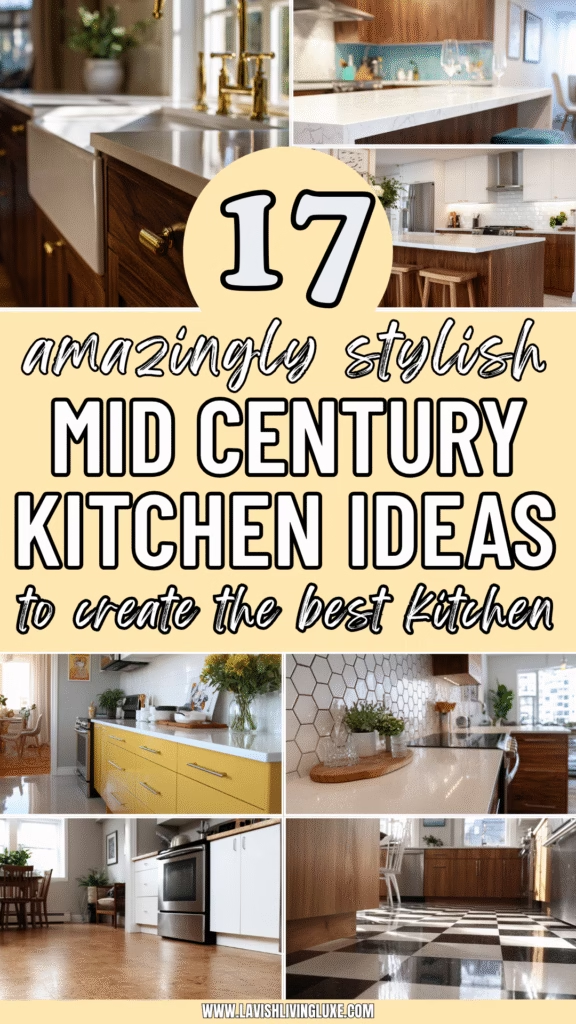
17 Mid Century Modern Kitchen Ideas
1. Warm Walnut Flat-Panel Cabinets for Classic Appeal
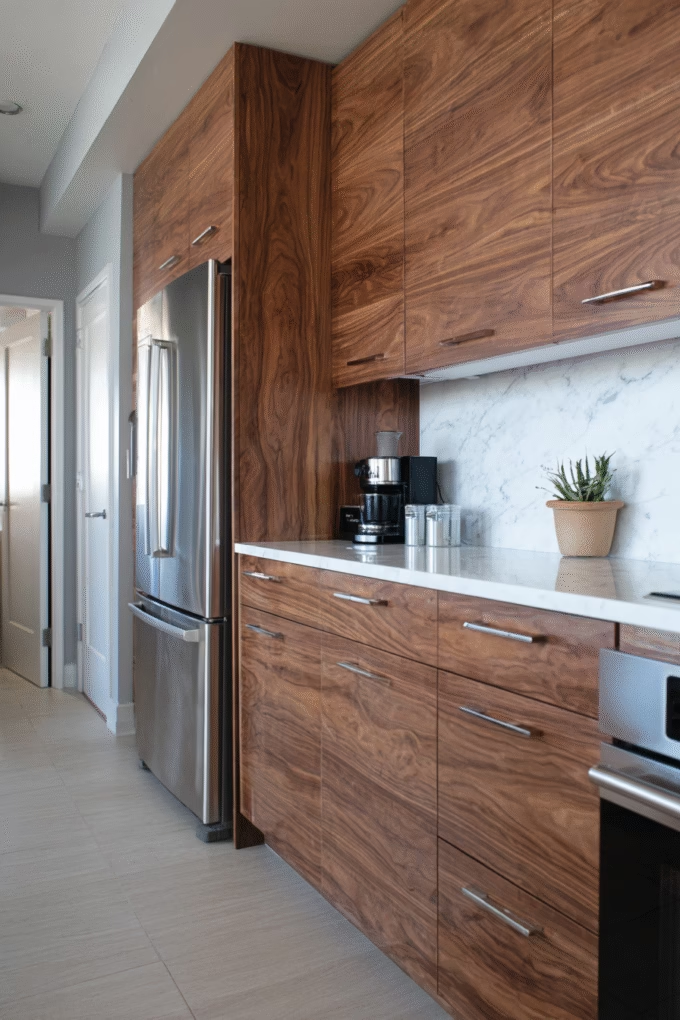
Want to nail the quintessential mid mod kitchen aesthetic?
Flat-panel walnut cabinets deliver that signature horizontal grain pattern that defined the era!
The rich, warm tones create visual interest without overwhelming your space.
Pair them with integrated handles for that sleek, uninterrupted look that midcentury modern kitchen designs are famous for.
Why we love this idea: Walnut cabinetry brings instant warmth and authenticity to any kitchen space. The natural wood grain tells its own story while maintaining that clean, minimalist profile that makes mid-century design so appealing.
Why this idea works: The horizontal grain pattern elongates your kitchen visually, making even smaller spaces feel more expansive. Walnut’s durability means your investment will look stunning for decades, and it pairs beautifully with both neutral and bold accent colors.
2. Terrazzo Flooring for Authentic Retro Vibes
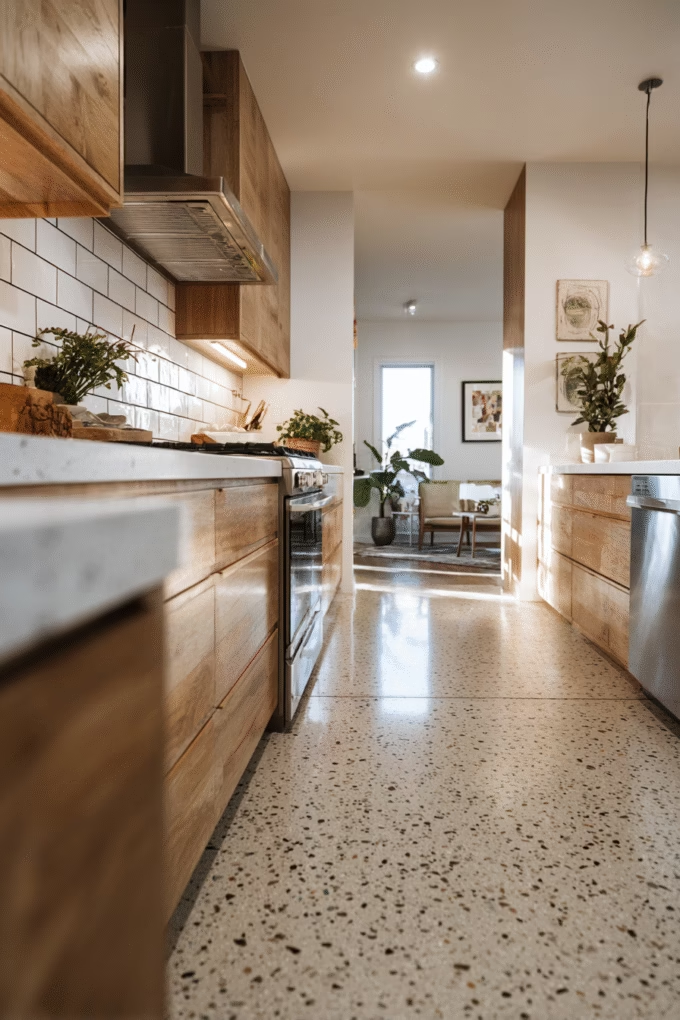
How about bringing one of the most iconic mid-century elements right under your feet?
Terrazzo flooring was everywhere in the 1950s and 60s, and it’s making a major comeback!
Those speckled patterns add visual texture without competing with your other design elements.
Choose neutral bases with colorful chips for a playful yet sophisticated foundation.
Why we love this idea: Terrazzo is incredibly durable and ages beautifully, developing character over time rather than showing wear. The speckled surface hides dirt and imperfections better than solid flooring, making it practical for busy kitchens.
Why this idea works: The multi-colored chips in terrazzo tie together various design elements in your kitchen, creating visual cohesion. It’s also low-maintenance and easy to clean, which matters in a high-traffic space like a kitchen.
3. Olive Green Accent Cabinetry for Earthy Sophistication
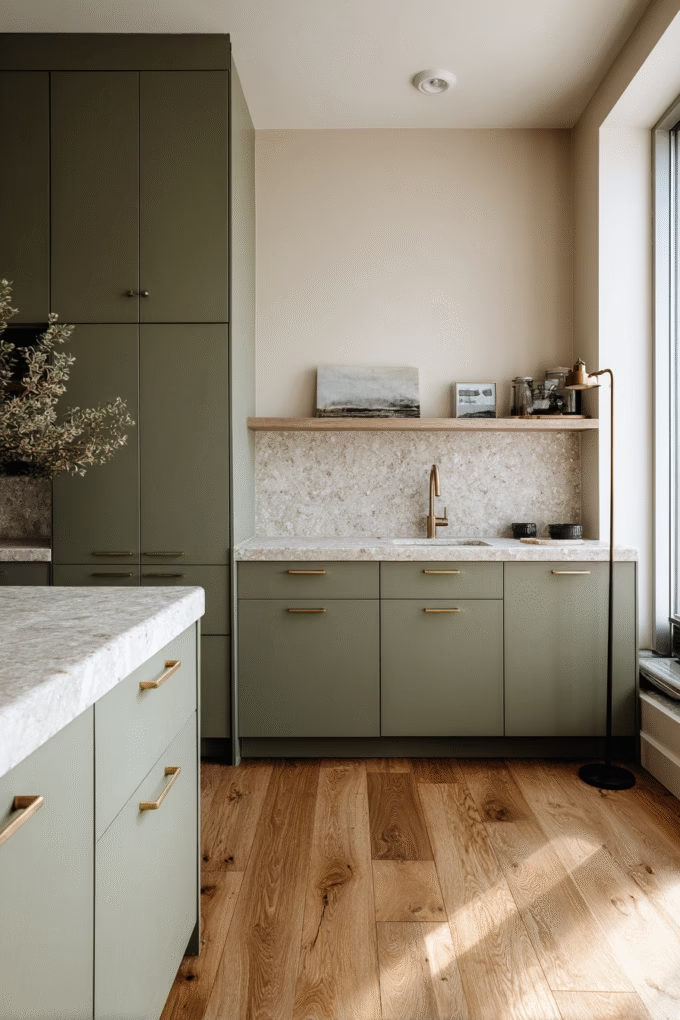
Want a color that screams mid-century without being too bold?
Olive green cabinets bring that perfect earthy, nature-inspired palette that defined the era!
This muted tone adds personality while remaining surprisingly versatile and timeless.
Combine it with brass hardware and natural wood accents for maximum impact.
Why we love this idea: Olive green hits that sweet spot between bold and neutral, adding character without overwhelming your senses. It’s a color that feels both vintage and surprisingly contemporary, making it perfect for long-term design investments.
Why this idea works: This earthy hue pairs beautifully with the warm wood tones and brass accents common in mcm kitchen designs. Olive green also complements white countertops and stainless appliances, making it easy to integrate into your existing layout.
4. Geometric Tile Backsplash for Visual Interest
Want to add pattern without overwhelming your mid century modern kitchen?
Geometric tile backsplashes deliver that perfect balance of visual interest and retro authenticity!
Think hexagons, diamonds, or elongated rectangles in stacked formations.
Keep colors relatively neutral or choose one bold accent to make the pattern pop.
Why we love this idea: Geometric patterns were a hallmark of mid-century design, appearing everywhere from wallpaper to textiles to architectural details. A geometric backsplash brings this playful element into your kitchen in a practical, easy-to-clean format.
Why this idea works: The repetitive geometric pattern creates rhythm and movement in your kitchen design. It draws the eye horizontally, making walls appear wider, and the three-dimensional quality of tile adds depth to flat surfaces.
Imagine This: IMG_9856.HEIC: Taken with a Canon camera, f/3.6 aperture, ISO 345, 1/108 shutter speed, photographed from eye level with ceiling not in view, the space is perfectly and brightly lit with even, natural-looking illumination. White elongated hexagonal tiles form a stacked geometric pattern along the kitchen backsplash, their glossy surface reflecting light beautifully. Medium-tone walnut cabinets frame the backsplash above and below, and a simple white quartz countertop provides the base. The geometric pattern creates subtle shadow lines that add dimensional interest, and the space feels bright and modern in this realistic, lived-in home.
Alt text: White geometric hexagonal tile backsplash in modern mid-century kitchen
5. Open Shelving With Minimal Styling
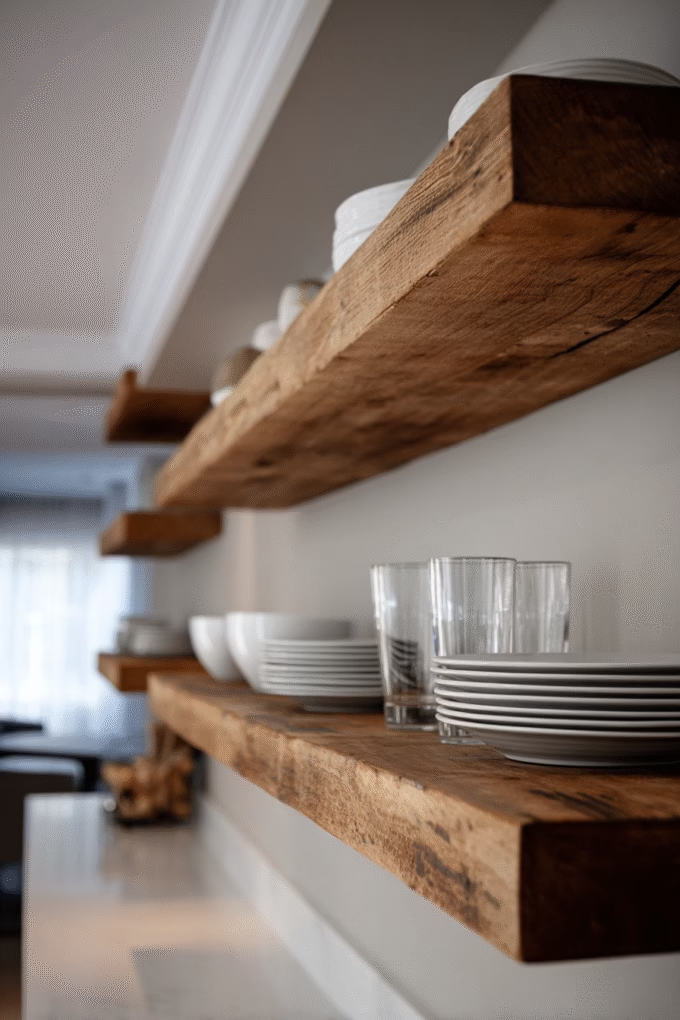
How about ditching some upper cabinets for that airy, open feeling?
Open shelving was a radical idea in midcentury modern kitchen designs, emphasizing accessibility and visual lightness!
Display your beautiful dishware and glassware as functional art.
Keep styling minimal and intentional—less truly is more in this aesthetic.
Why we love this idea: Open shelving forces you to be intentional about what you keep and display, naturally leading to a more curated, uncluttered space. It makes frequently used items easily accessible and adds a personal touch that closed cabinets can’t provide.
Why this idea works: Removing upper cabinets opens up sightlines and makes kitchens feel larger and less boxy. The horizontal lines created by shelving emphasize width, and displaying dishware adds color and personality without additional decor.
6. Butcher Block Countertops for Organic Warmth
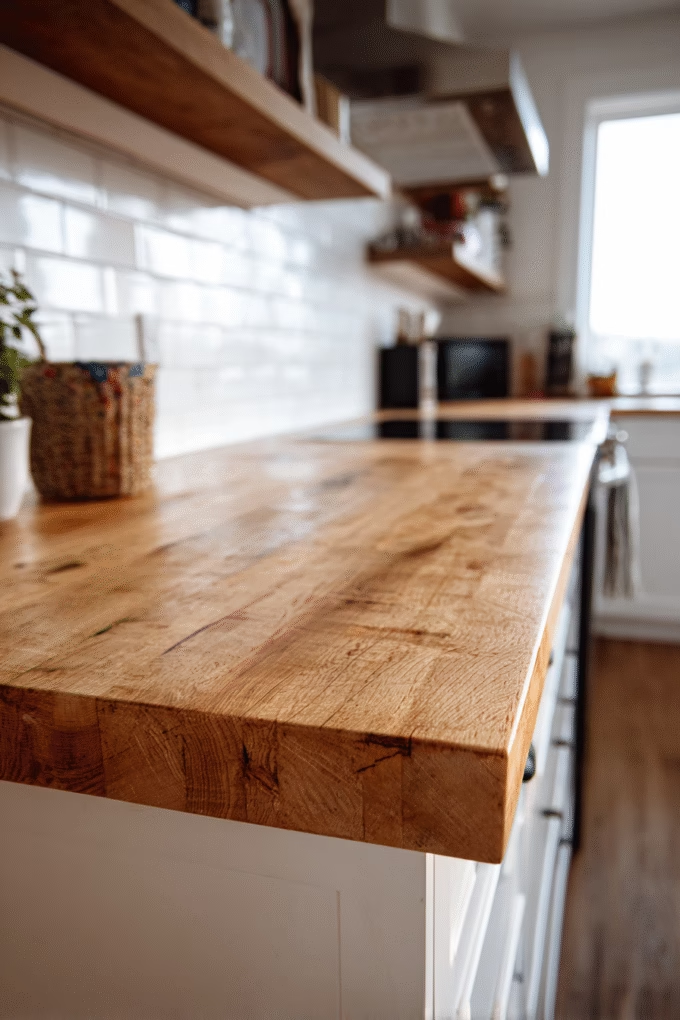
Want to bring natural texture into your retro kitchen?
Butcher block countertops add instant warmth and that handcrafted quality mid-century designers loved!
The wood surface develops a beautiful patina over time, telling the story of your family’s meals.
Pair with white or colored cabinets to let the wood grain take center stage.
Why we love this idea: Butcher block brings living, breathing material into your kitchen that actually improves with age and use. The natural antibacterial properties of wood make it surprisingly practical, and it’s gentle on knives and dishware.
Why this idea works: Wood countertops soften the hard edges of appliances and cabinetry, creating a more inviting workspace. They’re also more affordable than stone alternatives and can be sanded and refinished if they get damaged, extending their lifespan significantly.
7. Sputnik-Style Pendant Lighting for Dramatic Flair
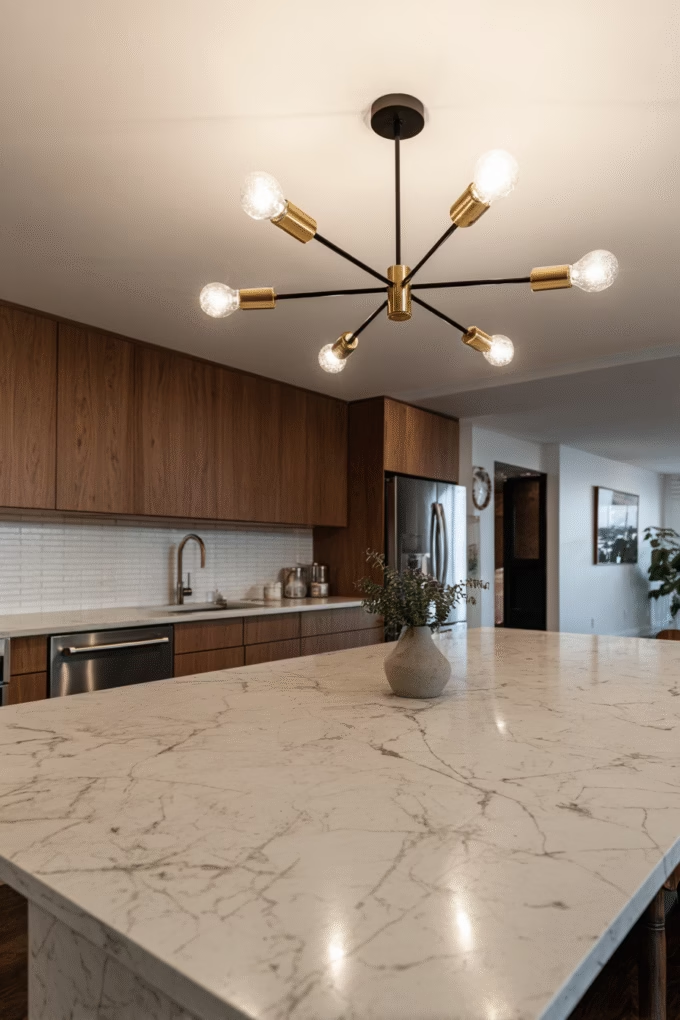
How about lighting that doubles as sculpture?
Sputnik pendant lights bring that atomic-age excitement to your midcentury modern kitchen!
Multiple arms extending from a central sphere create fascinating shadows and visual drama.
Hang one over your island or dining area for maximum impact.
Why we love this idea: Sputnik lighting was inspired by the space race and represents the optimism and forward-thinking attitude of the mid-century era. It’s functional art that provides excellent light distribution while looking absolutely stunning.
Why this idea works: The multi-directional arms cast light in all directions, eliminating shadows and creating even illumination. The open, airy design doesn’t visually block space the way solid pendants can, maintaining that sense of openness.
8. Color-Blocked Cabinet Doors for Playful Energy
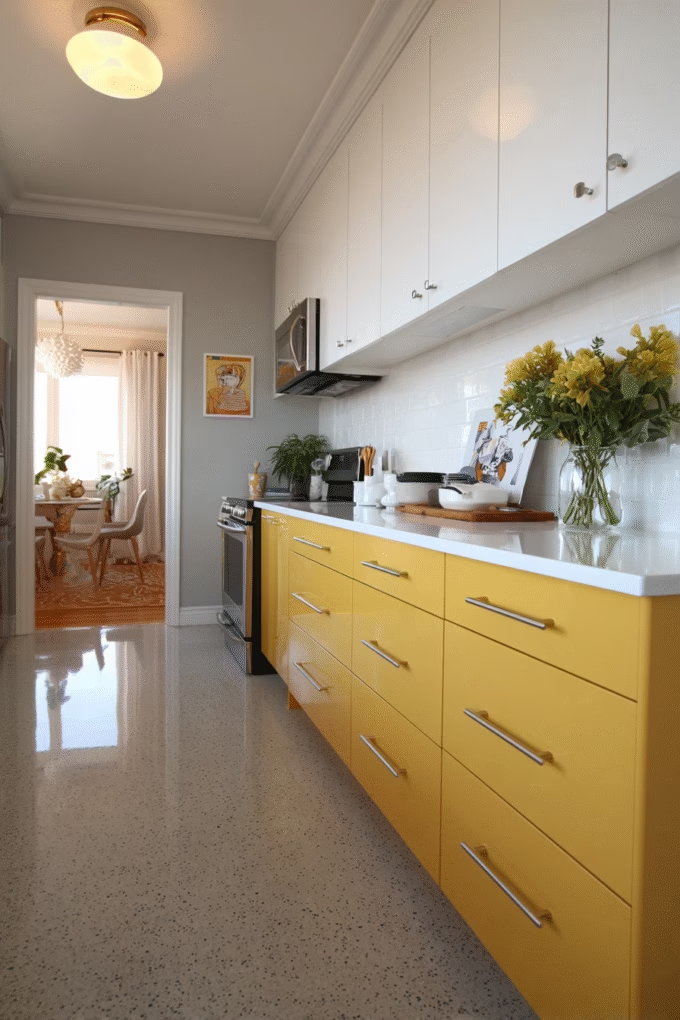
Want to add personality without committing to a full-color kitchen?
Color-blocked cabinets bring that playful mid-century spirit through strategic paint placement!
Try painting upper and lower cabinets in different shades—think mustard yellows, burnt oranges, or teals.
Keep other elements neutral so your cabinet colors can truly shine.
Why we love this idea: Color-blocking was a graphic design principle that mid-century designers applied to everything, including cabinetry. It creates visual interest through contrast while maintaining clean lines and simplicity.
Why this idea works: Separating upper and lower cabinets with different colors breaks up large expanses of cabinetry, making kitchens feel less monolithic. It also allows you to incorporate bold colors in manageable doses.
9. Integrated Appliances for Seamless Design
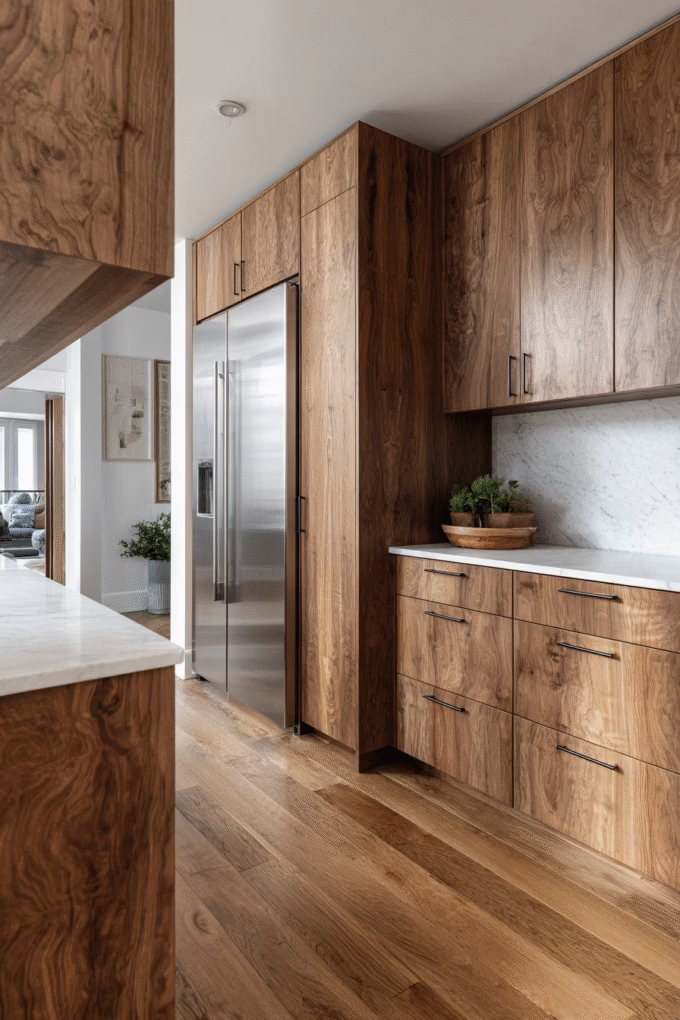
Want your mid mod kitchen to feel cohesive and intentional?
Integrated appliances hide behind cabinet panels, maintaining those clean lines that define the style!
Panel-ready refrigerators and dishwashers disappear into your cabinetry.
This approach lets your material choices and overall design shine without visual interruption.
Why we love this idea: Mid-century design emphasized simplicity and visual flow, and integrated appliances take this principle to its logical conclusion. They create a streamlined appearance that feels sophisticated and intentional.
Why this idea works: Hiding appliances behind matching panels eliminates visual clutter and makes kitchens feel larger and less busy. It also gives you more flexibility with cabinet colors and finishes since you don’t need to coordinate with stainless steel.
10. Brass Hardware and Fixtures for Golden Accents
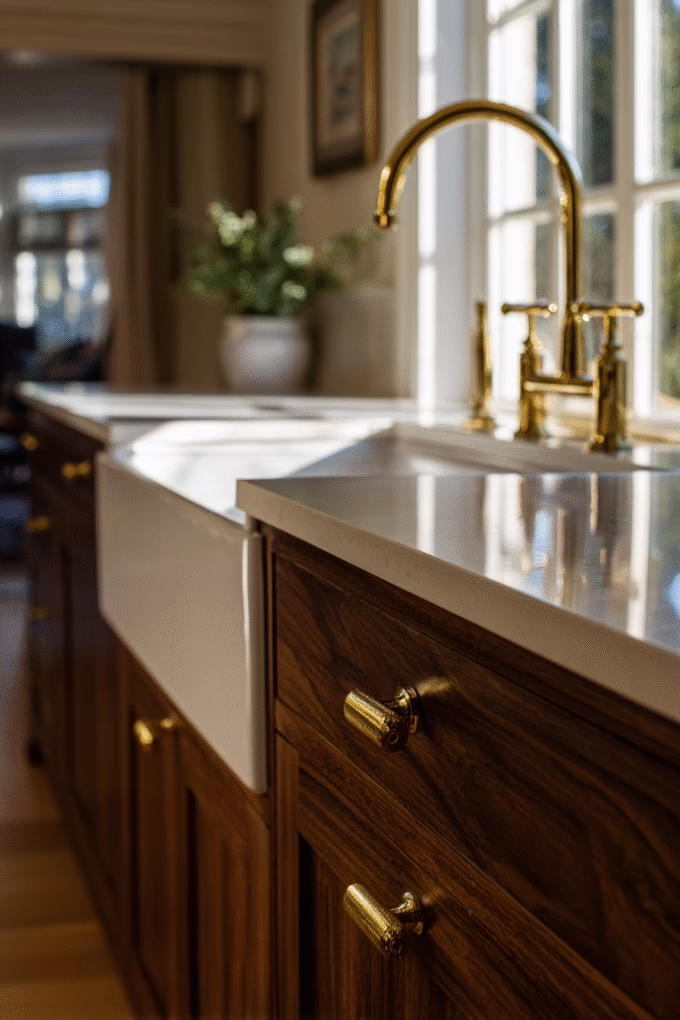
How about adding warmth through metallic details?
Brass cabinet pulls, faucets, and light fixtures bring that glamorous golden glow!
The warm metallic tone complements wood cabinetry beautifully and adds luxury.
Mix brass with other natural materials for a balanced, sophisticated look.
Why we love this idea: Brass was the metallic finish of choice during the mid-century era, prized for its warmth and elegance. Unlike chrome or stainless steel, brass develops a living patina that adds character over time.
Why this idea works: The golden tones in brass create visual warmth that counterbalances cool-toned elements like stainless appliances or white countertops. Brass also provides enough contrast against wood cabinetry to make hardware visible without being jarring.
11. Waterfall Edge Countertops for Sculptural Drama
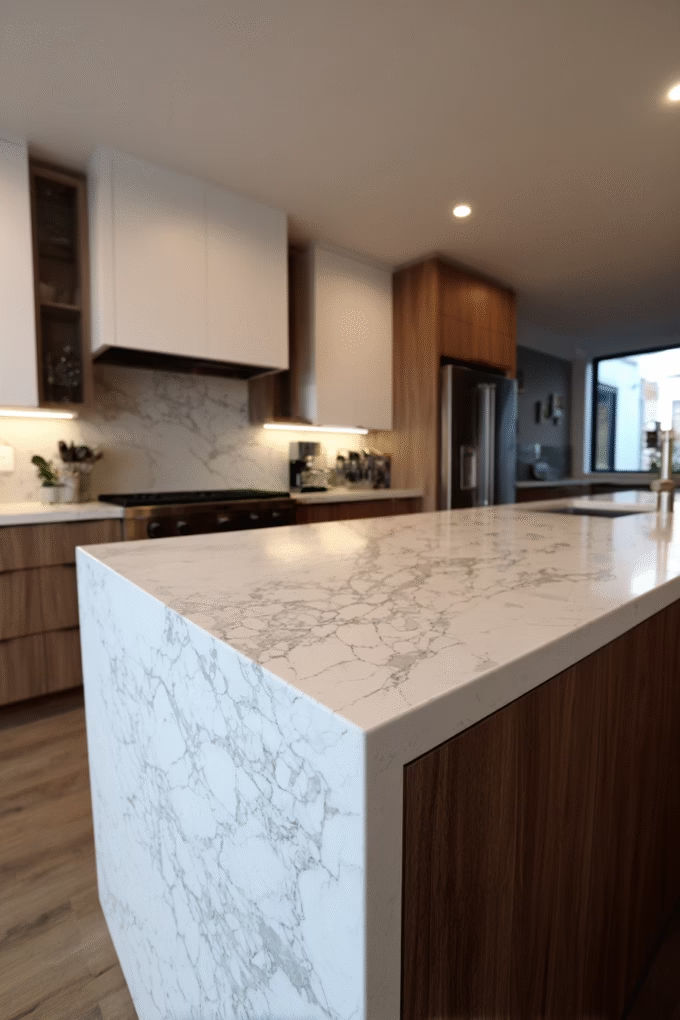
Want to create a statement piece in your mid century modern kitchen?
Waterfall edge countertops extend material down the sides of islands or peninsulas for a continuous flow!
This architectural detail emphasizes the beauty of your chosen countertop material.
Works especially well with marble, quartz with bold veining, or wood butcher block.
Why we love this idea: The waterfall edge is a contemporary interpretation of mid-century principles—it’s sculptural, emphasizes material honesty, and creates clean vertical lines. It transforms a functional element into an artistic focal point.
Why this idea works: The continuous surface creates visual cohesion and makes islands appear more substantial and furniture-like. It also protects island sides from kicks and scuffs while showcasing the full beauty of premium countertop materials.
12. Cork Flooring for Sustainable Retro Appeal
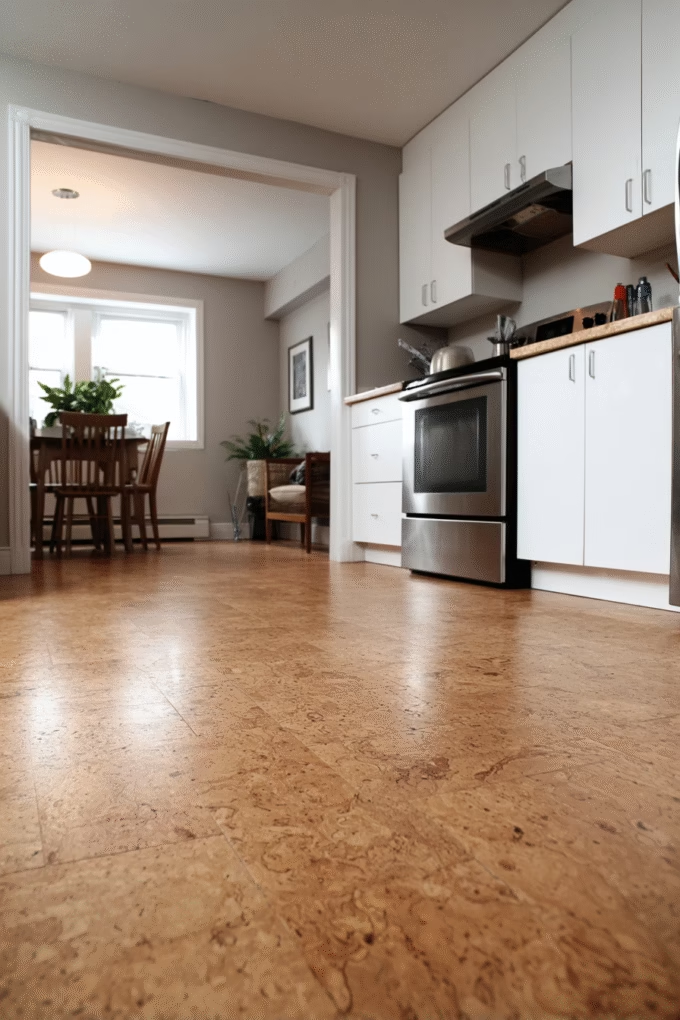
Want an eco-friendly option that’s authentically mid-century?
Cork flooring brings warmth, cushioning, and that distinctive texture that was popular in the 1950s and 60s!
The natural honeycomb structure provides comfort underfoot during long cooking sessions.
Choose natural tones or stained versions to complement your cabinet colors.
Why we love this idea: Cork is sustainable, naturally antimicrobial, and incredibly comfortable to stand on—important in a space where you spend hours cooking. Its natural texture and warm color palette fit perfectly with mid-century design principles.
Why this idea works: Cork’s slight give reduces fatigue when standing, making it ideal for kitchens. It’s also naturally insulating and sound-absorbing, creating a quieter, more comfortable environment than hard tile or stone.
13. Vinyl Bar Stools With Tapered Legs
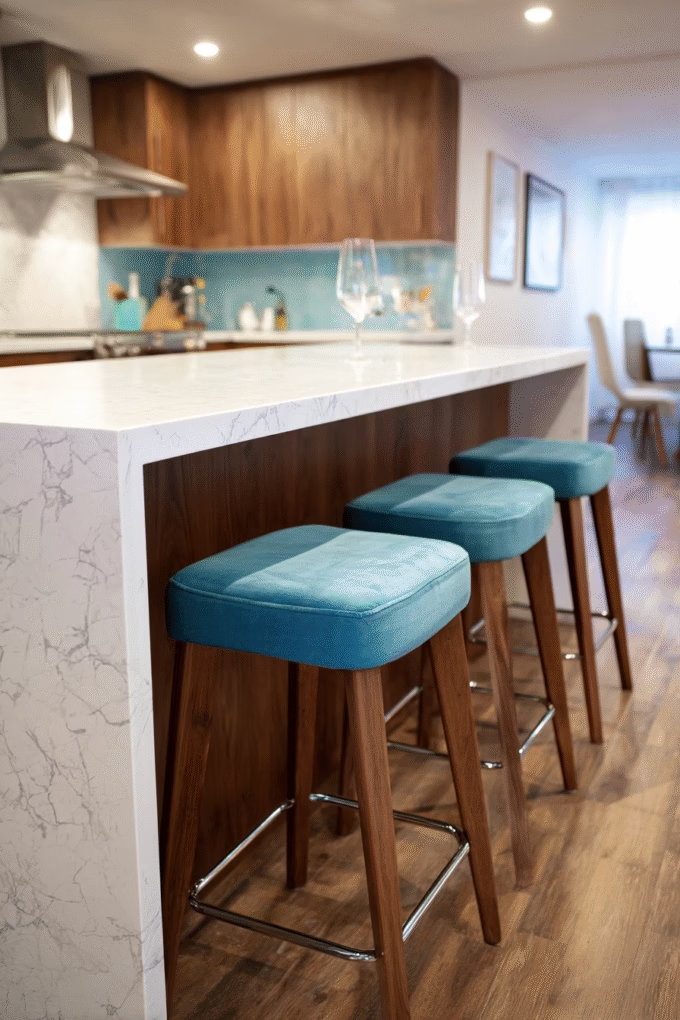
How about seating that’s unmistakably mid-century?
Bar stools with vinyl seats and angled wood legs bring authentic retro diner vibes!
Look for designs with low backs and swivel functionality for casual comfort.
Choose colors like red, teal, or orange to inject playful energy at your island or counter.
Why we love this idea: These stools combine the organic forms (tapered wood legs) with synthetic materials (vinyl upholstery) that defined mid-century design. They’re comfortable, easy to clean, and instantly recognizable as period-appropriate.
Why this idea works: The angled legs create visual interest and their splayed design provides stability without visual bulk. Vinyl is practical for kitchen use—resistant to spills and easy to wipe clean after messy cooking sessions.
14. Horizontal Wood Slat Accent Wall
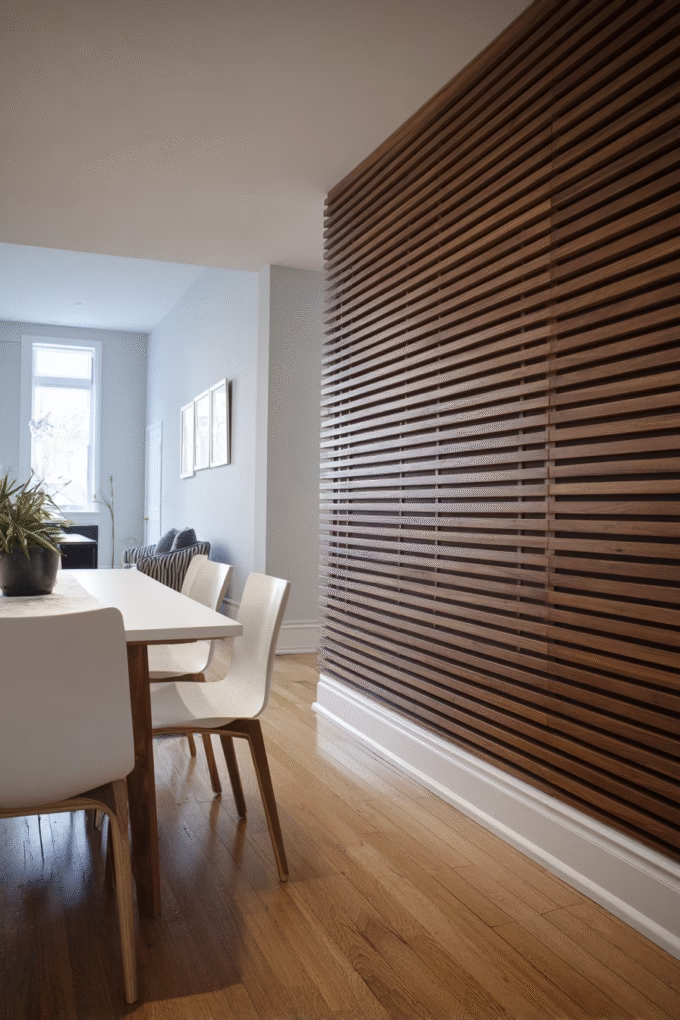
Want to add texture and architectural interest to your retro kitchen?
Wood slat walls bring that signature mid-century layering and natural material celebration!
Horizontal slats emphasize width and create compelling shadow play throughout the day.
Use them on one accent wall behind dining areas or as a backdrop for open shelving.
Why we love this idea: Wood slats add three-dimensional texture that flat painted walls can’t match. They celebrate natural materials while creating rhythm through repetition—both key mid-century design principles.
Why this idea works: The horizontal orientation makes walls appear wider and rooms feel more expansive. Slats also provide excellent acoustic dampening, reducing echo in kitchens with hard surfaces like tile and stone.
15. Peninsula Seating for Casual Dining
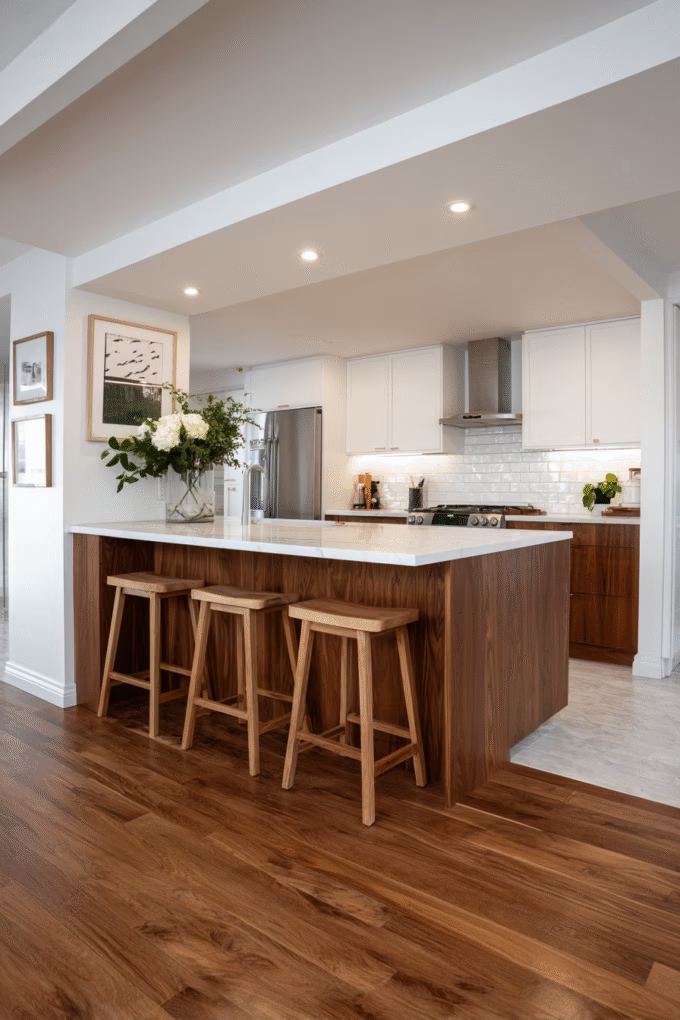
Want to maximize space while creating a social cooking environment?
A peninsula with overhang seating brings the dining experience right into your midcentury modern kitchen!
This layout promotes conversation while keeping prep and dining zones distinct.
It’s perfect for casual meals, homework sessions, or morning coffee.
Why we love this idea: Peninsulas create natural traffic patterns and define space without walls—very much in line with mid-century open-plan living. The extended counter provides additional prep space that doubles as a dining surface.
Why this idea works: Counter-height seating brings diners closer to cooking action, making kitchens feel more social and inclusive. It also requires less floor space than a separate dining table, making it ideal for smaller homes or apartments.
16. Vinyl or Linoleum Sheet Flooring in Bold Patterns
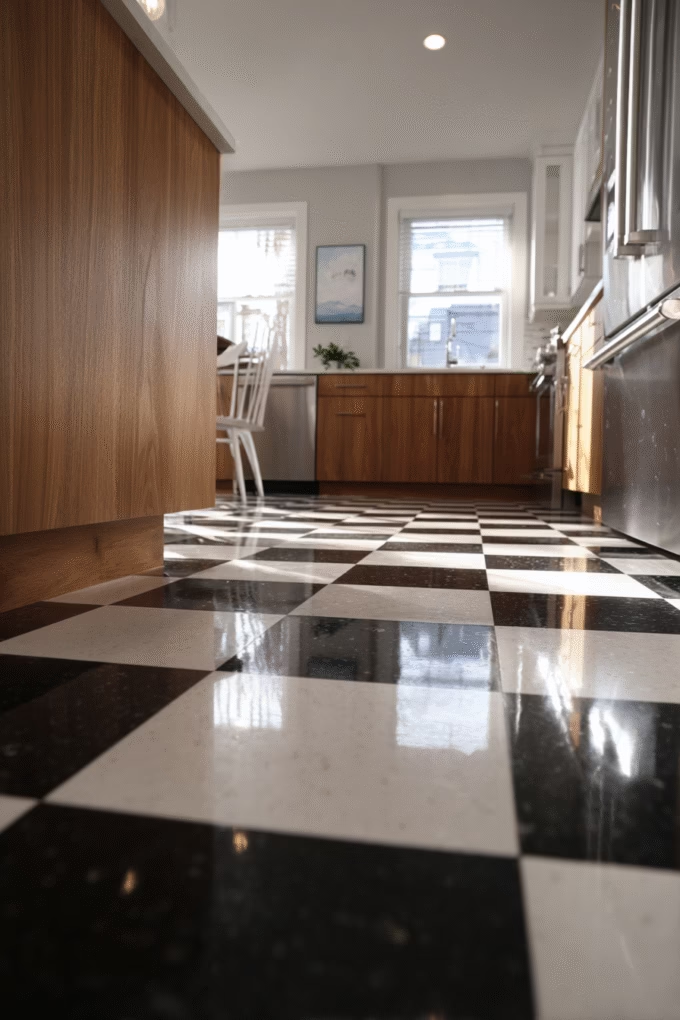
How about an authentically retro flooring choice that’s making a comeback?
Modern vinyl and linoleum offer the bold patterns and colors of vintage sheet flooring with improved durability!
Look for geometric patterns, checkerboard designs, or abstract shapes in period-appropriate colors.
This flooring choice brings instant personality and nostalgic charm.
Why we love this idea: Sheet vinyl and linoleum were the height of modernity in the 1950s and 60s, representing cutting-edge synthetic materials. Today’s versions are eco-friendly, comfortable underfoot, and available in countless retro-inspired patterns.
Why this idea works: These materials are affordable, water-resistant, and easy to install compared to tile or hardwood. The large sheets mean fewer seams, creating a more unified appearance, and the cushioned surface is comfortable for standing.
17. Teak Wood Accents and Accessories
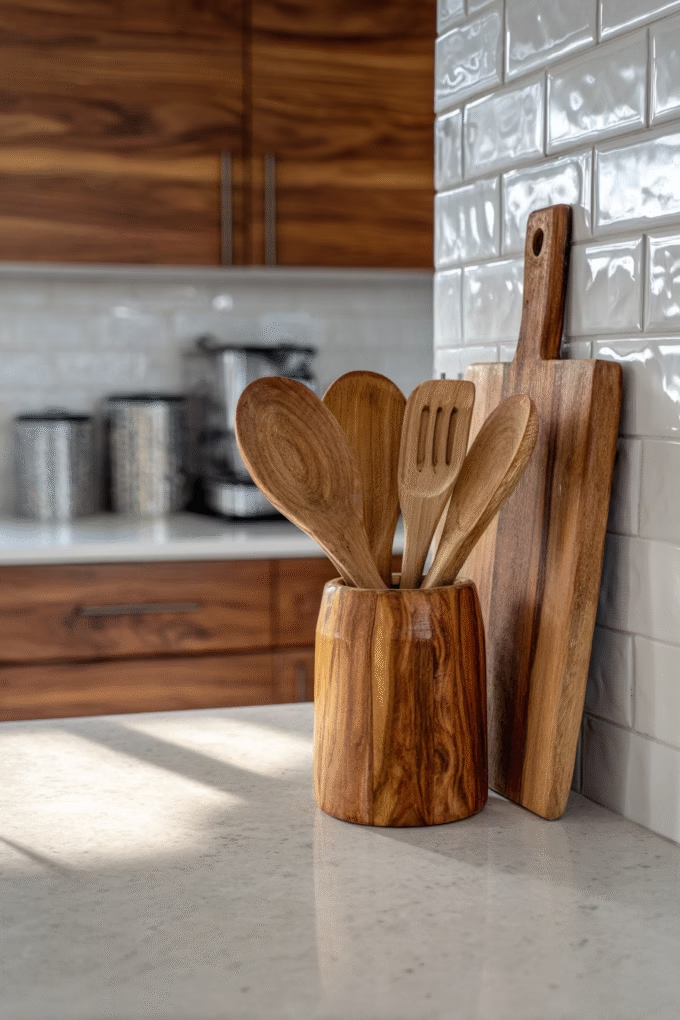
Want to bring in smaller touches of that iconic mid mod kitchen material?
Teak wood accessories like cutting boards, utensil holders, and trays add warmth in manageable doses!
The rich golden-brown tones and distinctive grain patterns are instantly recognizable.
Mix teak accents with your existing cabinet materials for layered visual interest.
Why we love this idea: Teak was prized during the mid-century era for its beauty and durability. Small teak accessories are an affordable way to introduce this luxurious wood without the commitment of full cabinetry.
Why this idea works: The warm tones of teak complement virtually any color scheme, from bold accent colors to neutral palettes. As functional items that live on your counters, these pieces bring the mid-century aesthetic into daily use.
Conclusion
Your mid century modern kitchen journey starts with choosing elements that speak to your personal style!
Whether you embrace warm walnut cabinetry, bold accent colors, or geometric patterns, these design ideas bring timeless appeal.
The beauty of midcentury modern kitchen design lies in its flexibility—mix authentic vintage pieces with contemporary interpretations.
Start with one or two key elements like flat-panel cabinets or terrazzo flooring, then build your dream retro kitchen from there.
Remember, the best mcm kitchen balances form and function, creating a space that’s both beautiful and livable for your family’s daily life!
